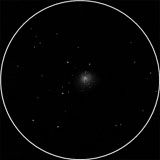
| MESSIER 30 |
|---|
RA: |
21h 40m 24s |
|
DEC: |
-23° 11' 00'' |
|
Type: |
Globular cluster |
|
NGC: |
7099 |
|
Magnitude: |
7.20 |
|
Surface brightness : |
12.34 |
|
Apparent dimensions : |
12.0'x12.0' |
|
Distance: |
26,000 ly |
|
Discovered 1764. by Charles Messier. Globular cluster M30, at about 26,000 light years distance and about 90 light years across, and appears to us under an angular diameter of about 12.0 arc minutes. It is fairly dense (as its concentration class V indicates), and a fine object in even small telescopes. Its brightest red giant stars are about of apparent visual magnitude 12.1, its horizontal branch giants at magnitude 15.1. Only about 12 variable stars have been found in this globular cluster. It is approaching us at 181.9 km/s. The core of M30 exhibits an extremely dense stellar population, and has undergone a core collapse, similar to at least 20 other of the 150 globulars in the Milky Way Galaxy, including M15, M70, and possibly M62. Consequently, M30's core is very small in extension, only about 0.12 arc minutes (7.2 arc seconds, corresponding to a linear diameter of 0.9 light years), and its half-mass radius is 1.15 arc min (8.7 light years); half of this cluster's mass is concentrated in a spherical volume of a radius equal to the distance of Sirius from us, or 17.4 light years diameter. On the other hand, its tidal radius is large: 18.34 arc minutes, corresponding to a linear radius of 139 light years. Beyond that distance, member stars would escape simply because of the Milky Way Galaxy's tidal gravitational forces. M30 was one of the original discoveries of Charles Messier, who cataloged it on August 3, 1764 and like most of his globulars, described it as round nebula, containing no stars. It was first resolved by William Herschel around 1784. The brightest stars of M30 can be seen in telescopes starting at or even just below 4-inch aperture. |
||
VEDRAN VRHOVAC© 2006.-2007. |
